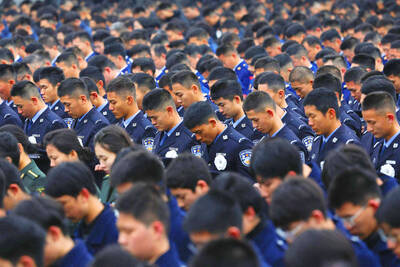The US could get a major trade boost from the soon-to-be-finished expansion of the Panama Canal, but experts worry poor infrastructure means Uncle Sam will miss the boat.
From 2014, some of the largest ships in the world will again fit through the 80km Panama Canal. Vessels carrying about 14,000 containers rather than today’s 5,000 will be able to cross the isthmus.
Traffic is expected to double through the inter-oceanic waterway, which already handles about 5 percent of world trade.
For people linked via the canal — most notably consumers in the eastern US and factory owners in China — that could spell cheaper goods and lower costs.
It could also provide US President Barack Obama with a late boost in his effort to double US exports by 2015 and help create jobs.
In Florida alone, the authorities believe upgrading the Port of Miami to handle these larger ships could help create 30,000 jobs.
However, during a visit to Washington last week the canal’s administrator Alberto Aleman Zubieta expressed concern that the US is not ready.
“There is a lot of infrastructure that basically needs to be upgraded,” he said, pointing to problems with dock length, port depth and rail and road links.
Like much of the US’ infrastructure, its ports are creaking from years of underinvestment and many even struggle to handle today’s largest “panamax” ship sizes.
“We don’t have the channel depths that are required to take the post-panamax vessels,” said Dave Sanford, of the American Association of Port Authorities.
The list of ports that do, he said, “is really short. It’s only one port: Norfolk [Virginia].”
While Baltimore, New York and Miami may also be ready by 2014, they handle a fraction of US trade and are not on the Gulf Coast, which serves consumers and exporters in the vast center of the US.
Perched on the meandering Mississippi, the Port of New Orleans is one of many facilities that has struggled to match infrastructure to its opportunities.
It is investing US$650 million on new canal-linked projects, mostly on container terminals, but chief executive Gary LaGrange said the port is still not at fighting weight.
“We’ll be ready, but not as ready as we could be, or should be,” he said.
Blame for the -unpreparedness is being spread far and wide: Former US president George Washington, the Army Corp of Engineers and Congress are all in the firing line.
Since Washington’s time the US Army has played a role ensuring waterways are navigable.
Even today, the Army Corps of Engineers — with one eye on its own limited budget and resources — must approve and execute many upgrades.
Congress, which is currently focused on cutting US debt, then has to approve funding.
That results in significant delays, according to many in the industry.
LaGrange said New Orleans already holds much sought-after permission to dredge its channel to 15m — enough to handle post-panamax ships.
However, bureaucracy means the project is on the back burner.
“Right now it is everything we can do to get the Corp of Engineers to maintain it at its current 47 foot [14.3m] depth,” he said.
Similarly, the Port of Beaumont, Texas, is waiting for approval of a US$1.2 billion project to deepen its channel, but even if the project is approved this year, it is likely to take 15 years to complete.
“Our system is broken, it’s just broken. It needs to be fixed,” said John Roby, head of the port’s customer services.
In the meantime, shippers are looking to deeper ports beyond the US; to Freeport in the Bahamas and Kingston in Jamaica.
“Unless we can get more channel capacity, they are going to be the primary beneficiaries of an expanded canal,” Sanford said.
Ultimately, that may cost US consumers.
“If you can’t take advantage of the economies of scale that the larger vessels offer,” said Paul Bingham, an economist with Wilbur Smith Associates, “the bottom line is it’s going to cost you more. For the economy that ultimately means that the consumers are going to be worse off.”

The Burmese junta has said that detained former leader Aung San Suu Kyi is “in good health,” a day after her son said he has received little information about the 80-year-old’s condition and fears she could die without him knowing. In an interview in Tokyo earlier this week, Kim Aris said he had not heard from his mother in years and believes she is being held incommunicado in the capital, Naypyidaw. Aung San Suu Kyi, a Nobel Peace Prize laureate, was detained after a 2021 military coup that ousted her elected civilian government and sparked a civil war. She is serving a

China yesterday held a low-key memorial ceremony for the 1937 Nanjing Massacre, with Chinese President Xi Jinping (習近平) not attending, despite a diplomatic crisis between Beijing and Tokyo over Taiwan. Beijing has raged at Tokyo since Japanese Prime Minister Sanae Takaichi last month said that a hypothetical Chinese attack on Taiwan could trigger a military response from Japan. China and Japan have long sparred over their painful history. China consistently reminds its people of the 1937 Nanjing Massacre, in which it says Japanese troops killed 300,000 people in what was then its capital. A post-World War II Allied tribunal put the death toll

‘NO AMNESTY’: Tens of thousands of people joined the rally against a bill that would slash the former president’s prison term; President Lula has said he would veto the bill Tens of thousands of Brazilians on Sunday demonstrated against a bill that advanced in Congress this week that would reduce the time former president Jair Bolsonaro spends behind bars following his sentence of more than 27 years for attempting a coup. Protests took place in the capital, Brasilia, and in other major cities across the nation, including Sao Paulo, Florianopolis, Salvador and Recife. On Copacabana’s boardwalk in Rio de Janeiro, crowds composed of left-wing voters chanted “No amnesty” and “Out with Hugo Motta,” a reference to the speaker of the lower house, which approved the bill on Wednesday last week. It is

FALLEN: The nine soldiers who were killed while carrying out combat and engineering tasks in Russia were given the title of Hero of the Democratic People’s Republic of Korea North Korean leader Kim Jong-un attended a welcoming ceremony for an army engineering unit that had returned home after carrying out duties in Russia, North Korean state media KCNA reported on Saturday. In a speech carried by KCNA, Kim praised officers and soldiers of the 528th Regiment of Engineers of the Korean People’s Army (KPA) for “heroic” conduct and “mass heroism” in fulfilling orders issued by the ruling Workers’ Party of Korea during a 120-day overseas deployment. Video footage released by North Korea showed uniformed soldiers disembarking from an aircraft, Kim hugging a soldier seated in a wheelchair, and soldiers and officials